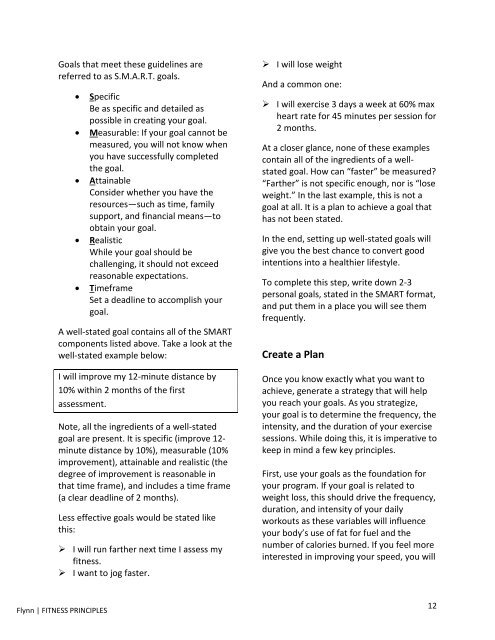Concepts of Fitness and Wellness 2e, 2018
Concepts of Fitness and Wellness 2e, 2018
Concepts of Fitness and Wellness 2e, 2018
Create successful ePaper yourself
Turn your PDF publications into a flip-book with our unique Google optimized e-Paper software.
Goals that meet these guidelines are<br />
referred to as S.M.A.R.T. goals.<br />
• Specific<br />
Be as specific <strong>and</strong> detailed as<br />
possible in creating your goal.<br />
• Measurable: If your goal cannot be<br />
measured, you will not know when<br />
you have successfully completed<br />
the goal.<br />
• Attainable<br />
Consider whether you have the<br />
resources—such as time, family<br />
support, <strong>and</strong> financial means—to<br />
obtain your goal.<br />
• Realistic<br />
While your goal should be<br />
challenging, it should not exceed<br />
reasonable expectations.<br />
• Timeframe<br />
Set a deadline to accomplish your<br />
goal.<br />
A well-stated goal contains all <strong>of</strong> the SMART<br />
components listed above. Take a look at the<br />
well-stated example below:<br />
I will improve my 12-minute distance by<br />
10% within 2 months <strong>of</strong> the first<br />
assessment.<br />
Note, all the ingredients <strong>of</strong> a well-stated<br />
goal are present. It is specific (improve 12-<br />
minute distance by 10%), measurable (10%<br />
improvement), attainable <strong>and</strong> realistic (the<br />
degree <strong>of</strong> improvement is reasonable in<br />
that time frame), <strong>and</strong> includes a time frame<br />
(a clear deadline <strong>of</strong> 2 months).<br />
Less effective goals would be stated like<br />
this:<br />
‣ I will run farther next time I assess my<br />
fitness.<br />
‣ I want to jog faster.<br />
‣ I will lose weight<br />
And a common one:<br />
‣ I will exercise 3 days a week at 60% max<br />
heart rate for 45 minutes per session for<br />
2 months.<br />
At a closer glance, none <strong>of</strong> these examples<br />
contain all <strong>of</strong> the ingredients <strong>of</strong> a wellstated<br />
goal. How can “faster” be measured?<br />
“Farther” is not specific enough, nor is “lose<br />
weight.” In the last example, this is not a<br />
goal at all. It is a plan to achieve a goal that<br />
has not been stated.<br />
In the end, setting up well-stated goals will<br />
give you the best chance to convert good<br />
intentions into a healthier lifestyle.<br />
To complete this step, write down 2-3<br />
personal goals, stated in the SMART format,<br />
<strong>and</strong> put them in a place you will see them<br />
frequently.<br />
Create a Plan<br />
Once you know exactly what you want to<br />
achieve, generate a strategy that will help<br />
you reach your goals. As you strategize,<br />
your goal is to determine the frequency, the<br />
intensity, <strong>and</strong> the duration <strong>of</strong> your exercise<br />
sessions. While doing this, it is imperative to<br />
keep in mind a few key principles.<br />
First, use your goals as the foundation for<br />
your program. If your goal is related to<br />
weight loss, this should drive the frequency,<br />
duration, <strong>and</strong> intensity <strong>of</strong> your daily<br />
workouts as these variables will influence<br />
your body’s use <strong>of</strong> fat for fuel <strong>and</strong> the<br />
number <strong>of</strong> calories burned. If you feel more<br />
interested in improving your speed, you will<br />
Flynn | FITNESS PRINCIPLES<br />
12


















